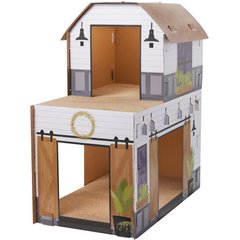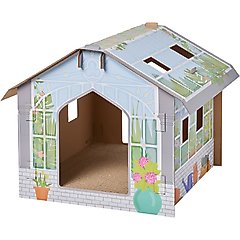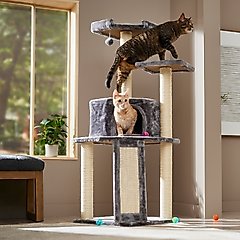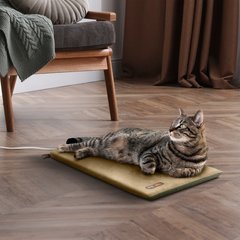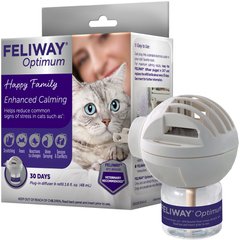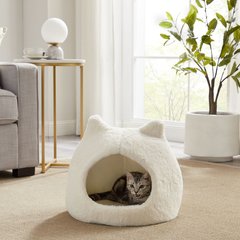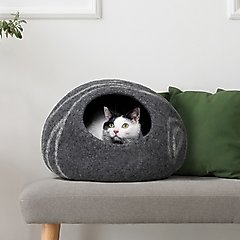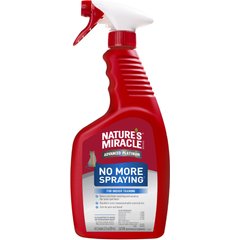Why Is My Cat Hiding? Is This Normal?

Photo by Chewy
You’re making dinner or watching TV when it hits you—you haven’t seen your cat in hours. You check all their usual spots. Still no sign. Cue the panic.
Naturally, you might start to wonder, “Why is my cat hiding?”
Most of the time, it’s totally normal behavior. But sometimes, it can be a sign of stress, illness, or something more serious. We asked cat experts to break down the most common reasons cats hide, where to look, and when to be concerned.
Key Takeaways
- Cats hide for many normal reasons, including stress, changes in routine, or just needing a break.
- Hiding can also be a sign your cat is sick or in pain—especially if the behavior is new or comes with other symptoms like not eating or avoiding the litter box.
- Some hiding spots, like recliners or dryers, can be dangerous. Always check these places before using them.
- Give your cat safe alternatives like cat trees, cardboard boxes, or heated beds to help them feel secure without risking their safety.
Why Is My Cat Hiding?
Instincts
Hiding is a natural instinct for cats. As both predators and prey in the wild, cats learn to hide to stay safe—or to sneak up on their own prey, says Marci Koski, a certified feline behavior and training consultant with Feline Behavior Solutions in Vancouver, Washington.
To Feel Safe
“Hiding makes them feel like they’ve got their back covered,” says Ingrid Johnson, a certified cat behavior consultant and the owner of Fundamentally Feline, in Atlanta, Georgia. Cats often retreat when something unfamiliar is going on.
Illness or Pain
Cats also hide when they’re not feeling well, says Gabrielle Fadl, DVM, senior director of medical quality and operations at Bond Vet in Brooklyn, New York.
It’s an instinct to protect themselves from predators. They may avoid their usual spots and choose out-of-the-way places instead. Look for other signs like:
- Not eating
- Overgrooming
- Avoiding people
- Lip licking
- Hunching
- Digestive problems, like diarrhea or vomiting
- Increased vocalization
- Going outside of the litter box
Stress or Anxiety
Cats may also hide if they’re stressed—like when they’ve just been adopted or after a big change at home. Hiding gives them a sense of control. Other signs of stress include:
- Hiding or avoiding interaction
- Decreased appetite or changes in eating habits
- Increased vocalization, such as meowing, hissing, or growling
- Excessive grooming or loss of fur
- Avoiding the litter box
- Aggressive behavior
Pregnancy
If your cat isn’t spayed, she may be hiding because she’s pregnant and looking for a safe, quiet place to give birth, says Dr. Fadl.
Common Cat Hiding Places
Cardboard Boxes
Cats love cardboard boxes because they’re cozy, warm, and feel safe.
“Cardboard boxes help them regulate body temperature without expending energy,” says Johnson. They’re a great hiding place you can encourage with little effort.
If your cat loves to hide out in cardboard boxes, try giving them cardboard cat houses with fun designs.
Recommended Products
Closets
Closets are scent-heavy, often smell like you, and are full of soft clothes. They’re also dark and quiet—perfect for a stressed or shy cat. Some even enjoy climbing to higher shelves to watch from above.
Behind or Under Furniture
Beds, couches, and chairs are dark, undisturbed, and low to the ground, making them ideal for hiding. Some cats choose low spots because they’re not big jumpers or just don’t like heights.
Avoid recliners or furniture with moving parts—they can be dangerous.
Warm Places
Cats love warmth, so spots near heaters or furnaces are popular. But be careful: Places like the dryer can be risky. Always check these areas before use.
Cold Places
On the flip side, a sick cat may seek out cool places, like tile floors or shady corners.
If your cat is lying on a cold surface and acting off, it might be time for a vet visit.
Popular Cat Hiding Places
Cats can squeeze into all kinds of strange spots. Here’s a list of popular hiding places, both safe and risky:
- Cardboard boxes
- Closets
- Behind, under, or in furniture
- Warm or cold places
- Behind curtains
- In the sink
- Behind the fridge
- In suitcases or bags
- Under the porch
- Inside drawers
- Under indoor or outdoor plants
- In car wheels or under the hood
- In cabinets
- In laundry baskets
- In the washing machine or dryer
- In dressers or wardrobes
- In box springs
- Under blankets
While most of these spots are harmless, some can be dangerous:
- Recliners and box springs: Cats can get crushed or trapped when someone reclines or moves the furniture.
- Washers and dryers: These warm spots are tempting, but a cat can get accidentally trapped inside.
- Car engines or wheels: Outdoor cats may hide here for warmth or safety, but it’s extremely risky if the car is started.
Here are tips to help keep your cat safe:
- Always check appliances and recliners before use.
- Keep doors to machines and furniture closed when not in use.
- Block off access to dangerous areas.
- Offer safe alternatives like cardboard boxes, heated beds, or enclosed cat condos.
Should I Be Worried if My Cat Is Hiding?
Hiding is usually nothing to fret over. But there are some instances when it might be an issue, such as:
- Illness
- Anxiety
- Hiding in unsafe places
If hiding is a new thing or if your cat is showing other symptoms of pain or illness, such as not eating, you should take them to the vet to make sure there isn’t something more serious going on.
Why Is My Cat Suddenly Hiding?
If your cat starts hiding out of the blue, it could be a sign that something’s off. A sudden change in behavior—especially if they’re skipping meals, avoiding the litter box, or acting withdrawn—can point to illness, stress, or pain.
What Should I Do if My Cat Is Hiding?
There are some steps you can take to prevent your cat from hiding in places where you don’t want them.
Get a Cat Tree or Condo
Give your cat a safe place to escape with a cat tree or condo. These elevated or enclosed spaces let your cat retreat when they’re tired, overwhelmed, or just want a break. Plus, cat trees double as exercise and entertainment.
Recommended Product
Get a Heated Cat Bed
If your cat hides in warm but risky places (like the dryer), swap in a heated bed. Choose from self-warming (like the Frisco Self-Warming Bolster Bed) or electric options (like the K&H Pet Products Thermo-Kitty Mat Heated Cat Bed)—and add a towel for extra coziness.
Recommended Products
Try Cat Pheromones
For anxious cats, try synthetic cat pheromones, like Feliway Optimum. These mimic the scent cats naturally release when they feel calm, helping reduce stress and encourage relaxation.
Recommended Product
Get a Cat Cave
A cat cave is a cozy, covered bed that gives your cat a quiet place to nap or decompress away from the action.
Recommended Products
Use a Cardboard Box
Don’t underestimate a good old cardboard box. Fill it with cat blankets, cat treats, catnip, or cat toys to create an inviting hideaway your feline friend can call their own.
Recommended Products
Try Strong Scents
To discourage hiding in certain spots, try citrus, peppermint, or cinnamon scents—just avoid essential oils, which are toxic to cats. You can also try cat-safe deterrent sprays, like Nature’s Miracle Advanced Platinum.
Recommended Product
Don’t Scare Your Cat
Never yell, squirt, or startle your cat out of a hiding spot. This can damage trust and make them even more fearful. Instead, focus on making safe spaces more appealing.
FAQs About Why Cats Hide
How do I get my cat out of hiding?
Patience is key. Try placing their favorite treats or toys nearby to coax them out gently. Avoid forcing them or pulling them from their hiding spot. Instead, sit quietly nearby to help them feel safe enough to come out on their own.
Why do cats hide when they’re sick or dying?
Cats are instinctively wired to hide when they’re sick or near the end of life. In the wild, this helps them avoid predators when they’re vulnerable. If your cat is hiding more than usual and seems off, it’s always worth checking in with your vet.
Why is my cat hiding all of a sudden?
Sudden hiding can signal stress, illness, pain, or a big change in their environment. If this is new behavior—especially if it’s paired with other symptoms—schedule a vet visit to rule out anything serious.
Why is my cat hiding and not eating?
Hiding and not eating is often a red flag. Cats are masters at masking discomfort, so a loss of appetite plus hiding could mean your cat is in pain or sick. Contact your vet as soon as possible.
Why is my cat hiding under my bed?
The space under your bed is dark, quiet, and hard to reach—ideal from a cat’s perspective. It’s a safe-feeling spot, especially if they’re anxious or overstimulated. If it’s the only place they go and they’re avoiding food or interaction, talk to your vet.
